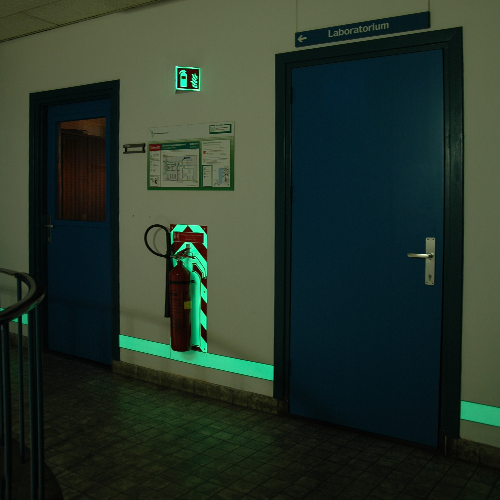- Markets
- Products
- Our work
- Downloads
- Standards and Laws
- Nieuws
- About us
- Contact
Geplaatst op 19 June 2018
Bio composite NPSP – With an eye on the circular economy, Blomsma Signs & Safety is investigating a new product line for sheet material. Safety signage for e.g. tank markings and composite signs is mostly applied to sheet material. To guarantee an acceptable lifespan, this is often done using aluminium or PET sheeting (often recycled). As an alternative to this, we have found a bio-composite from NPSP.
What is bio-composite?
A visit to the offices of NPSP, a producer of bio-composite for industrial and other applications, is very distinctly inspirational. Much as a baker might, the people at NPSP like to talk about the ‘dough’. It has to be left for a week after kneading, but after that it can be pressed into whatever form is desired. What then remains is a rock-hard material that retains its shape at temperatures from minus 60 to plus 180 degrees Celsius. NPSP makes this bio-composite material almost entirely from natural and ultra-Dutch raw materials such as straw, flax and hemp. Bio-composite is therefore a pressed sheet material, consisting of natural raw materials (waste products) that can be used in the signage industry and elsewhere.
Laboratory
At the NPSP laboratory in Amsterdam, the search is always on for new recipes for the increasingly demanding clientele. That includes companies from the logistics sector, the Dutch railways, the Dutch automobile association, industry and local and national authorities. It has been an ideal of the authorities and numerous companies for a number of years: rendering waste a thing of the past by reusing the product at the end of its economic life as new raw material. The buzzword is ‘circular’. It is a major step for all companies and governmental authorities that want to be serious about reducing their carbon footprint.
The five myths about composites
Because bio-composites have not yet been on the market for as long as traditional plastics, various myths have arisen about them that we would like to debunk.
Actually, bio-composites can be just as strong as steel. Plastics may perhaps have the image of being cheap, but high-quality materials reinforced with fibres are just as tough as steel, despite being significantly lighter and needing little maintenance. The noses of the new intercity trains for NS are made of bio-composite, for instance.
Bio-composites can be made in runs from just a few samples to thousands. Relatively low startup costs make it possible to develop prototypes and single items together with the client. Once the model meets all the requirements, a mould can be made for series production.
It’s certainly true that bio-composites are often used in aerospace and fast racing boats. However, it’s 2018 now and there a lot more applications: lounge seats for NS, shop window decorations for G-Star, route milestones for the ANWB, chairs, etc.
NPSP is in the vanguard for applying environmentally friendly materials and techniques. They are the only company in the Netherlands that uses natural materials such as flax, jute, coconut and hemp in addition to glass and carbon fibres. Natural fibres require less energy to produce and adhere to the resin without special chemicals being required. NPSP uses closed moulds, so the emissions of solvents are 95% less than normal. Carbon filters purify the remainder. With backing from the Ministry of Agriculture, Nature and Food Safety, NPSP is working on the development of entirely organic composites.
The properties of fibre-reinforced composites are providing inspiration for architects, designers and engineers. NPSP can make almost any conceivable shape – coarse or detailed, large or small, smooth or quirky. In terms of the shaping techniques, there are almost no limits. And NPSP pushes the materials to the limits too. Transparent resins leave the fibres visible and can enhance the desired appearance: playful, chic, sturdy or transparent. Translucent structures that can nevertheless take heavy loads, or can be screen-printed or given a colour the whole way through.
Natural renewal
As well as cutting down on the consumption of scarce raw materials, bio-composites save hugely on energy, compared to steel and aluminium production in particular and also with respect to hard plastics from petroleum. According to NPSP, the environment can benefit by a factor of as much as 5.
If you would like to know more about the possibilities of bio-composites for signage applications or elsewhere in your company, please contact us via signs.safety@blomsma.nl. We will be pleased to provide you with more information.

This article begins in Norway, a few hundred kilometres east of the UK and caught our eye because of this message on the marineschepen.nl website. The largest ship in the Norwegian ...

In order to be allowed to perform Surveys of Low Location Lighting Systems using phosphorescent materials on ships, high speed crafts and offshore units, Blomsma Signs & Safety is ...
Want to know more?
Contact us.